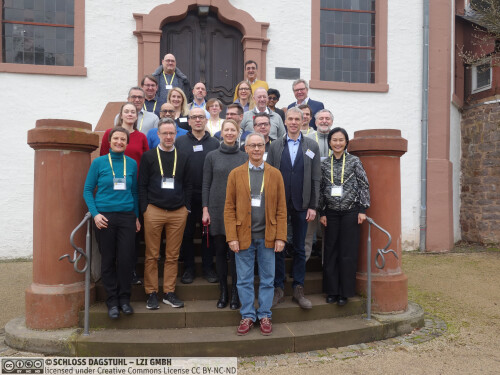Dagstuhl Seminar 25062
Extended Reality for the Operating Room (XR4OR)
( Feb 02 – Feb 07, 2025 )
Permalink
Organizers
- Peter Haddawy (Mahidol University - Salaya, TH)
- Anja Hennemuth (Charité - Berlin, DE)
- Ron Kikinis (Harvard Medical School - Boston, US)
- Gabriel Zachmann (Universität Bremen, DE)
Contact
- Andreas Dolzmann (for scientific matters)
- Jutka Gasiorowski (for administrative matters)
Shared Documents
- Dagstuhl Materials Page (Use personal credentials as created in DOOR to log in)
Schedule
The first day started with flash talks where participants could introduce themselves and present their work relevant to the Dagstuhl Seminar. In the afternoon, we discussed the overall outcome of the seminar in the group, a potential research roadmap paper, in order to build a common understanding and engagement with the topic. We also showcased about 10 demos, which several participants brought, so that all participants could get an impression of the current state of the art, and also in order to get everybody in the theme of the seminar. This proved to be very successful, even though participants had to bring all the VR hardware themselves.
Tuesday morning was dedicated to introducing the pain points that surgeons face in their daily work in the operating room to the non-medical attendees, i.e., the virtual reality experts and researchers. We had four talks by four surgeons, each one followed by discussions in order to gain a better understanding. The rest of the day was dedicated to generating a large number of ideas, some of which addressed the pain points, but many of them also were generated very creatively by the participants in break-out sessions using the brain-writing method. At the end of the day, participants presented their best ideas in the whole group. After dinner, the organizers sat down together in order to cluster all the ideas and create larger umbrella themes.
On Wednesday, the day began by presenting the clusters to all attendees, and by partitioning the group so that each cluster could be taken care of in break-out sessions. The rest of the day was filled by fleshing out the cluster themes and providing more details with the overarching research themes. On Wednesday night, the organizers sat down to create a framework document, to be used on Thursday for starting the writing process.
Thursday was dedicated to collaborative writing. To do so, each theme was further structured by the attendees, some themes were broken down into smaller sub themes, some of them were already narrow enough, so that in the end, we wrote in pairs on each and every topic.
On Friday, we discussed a number of opportunities and possibilities that would allow us to continue this collaboration as a group. To do so, the organizers presented all the possible funding opportunities we were aware of, and we collected some more from the audience. We also discussed a timeline, in order to produce a research roadmap, and we discussed next steps.
Future activities will include writing and publishing a collaborative paper, where each participant will contribute to one section. The paper is to provide perspectives on trends and future research on the seminar's topic, and also it can serve as a guideline or roadmap for researchers who like to enter this field. Further activities will strive to establish and broaden a community around the seminar's topic, by organizing workshops at prestigious VR conferences, such as IEEE VR. Eventually, we will apply for another Dagstuhl Seminar, with a broader participant list, and a somewhat broader topic.
 Peter Haddawy, Anja Hennemuth, Ron Kikinis, and Gabriel Zachmann
Peter Haddawy, Anja Hennemuth, Ron Kikinis, and Gabriel Zachmann
In the past decade, virtual reality (VR), augmented reality (AR), and extended reality (XR), in general, have seen a second wave due to consumer-level availability of VR devices. In the medical realm, XR has been investigated extensively and successfully for training, teaching, rehabilitation, and some forms of therapy (e.g., disorders).
However, XR also bears great potential for application in the operating room (OR) directly during operations, as an additional and powerful technology, which has been underexplored and under-researched so far. We believe that by making use of this technology during and for operations, patients’ well-being and many kinds of success metrics of operations can be improved.
The first goal of this Dagstuhl Seminar is to survey existing uses of any kind of XR technologies in the OR. More importantly, we will seek to foster and create ideas for novel research on using XR in the OR. This should lead to novel use cases of the technology, novel research questions, and an agenda for research on XR in the OR for the next 5 years. As one of the tangible outcomes, we plan to develop a position paper outlining this agenda during the seminar, and submit it to a major journal.
These goals will be achieved by bringing together researchers from all sub-fields of XR (VR, AR, sound and haptic rendering, new materials, and other kinds of mixed reality), along with practitioners (surgeons) from different medical areas, in order to bring the practical perspective of surgery to the seminar.
In the seminar, we will discuss the challenges in the OR (e.g., stressful work environment, digitalization, hand-eye coordination, occupancy of perception); we will conduct brainstorming (using creativity techniques such as brainwriting and brainwalking) to think about any potential use of XR technologies in the operating room; we will structure the ideas so as to prepare a potential position paper.
 Peter Haddawy, Anja Hennemuth, Ron Kikinis, and Gabriel Zachmann
Peter Haddawy, Anja Hennemuth, Ron Kikinis, and Gabriel Zachmann
Please log in to DOOR to see more details.
- Philippe C. Cattin (Universität Basel - Allschwil, CH) [dblp]
- Tanja Döring (Universität Bremen, DE)
- Simon Drouin (ETS - Montreal, CA)
- Gabor Fichtinger (Queen's University - Kingston, CA) [dblp]
- Tabea Flügge (Charité - Berlin, DE)
- Peter Haddawy (Mahidol University - Salaya, TH) [dblp]
- Anja Hennemuth (Charité - Berlin, DE) [dblp]
- Joaquim A. Jorge (University of Lisbon, PT) [dblp]
- Ron Kikinis (Harvard Medical School - Boston, US) [dblp]
- Luv Kohli (InnerOptic Technology - Hillsborough, US) [dblp]
- Mario Lorenz (TU Chemnitz, DE) [dblp]
- Rainer Malaka (Universität Bremen, DE) [dblp]
- Javier Pascau (Carlos III University of Madrid, ES)
- Dirk Reiners (University of Central Florida - Orlando, US) [dblp]
- Anke Reinschlüssel (Universität Konstanz, DE) [dblp]
- Andrea Schenk (Fraunhofer MEVIS - Bremen, DE) [dblp]
- Falko Schmid (Heinrich-Heine-Universitätsklinikum Düsseldorf, DE) [dblp]
- Siriwan Suebnukarn (Thammasat University - Pathum Thani, TH) [dblp]
- Verena Uslar (Universität Oldenburg, DE) [dblp]
- Gregory F. Welch (University of Central Florida - Orlando, US) [dblp]
- Rene Weller (Universität Bremen, DE)
- Dirk Weyhe (Universität Oldenburg, DE) [dblp]
- Sudanthi Wijewickrema (University of Melbourne, AU) [dblp]
- Gabriel Zachmann (Universität Bremen, DE) [dblp]
Classification
- Emerging Technologies
- Graphics
- Human-Computer Interaction
Keywords
- Virtual Reality
- Augmented Reality
- Extended Reality
- Medical Informatics
- Surgical Support





 Creative Commons BY 4.0
Creative Commons BY 4.0
